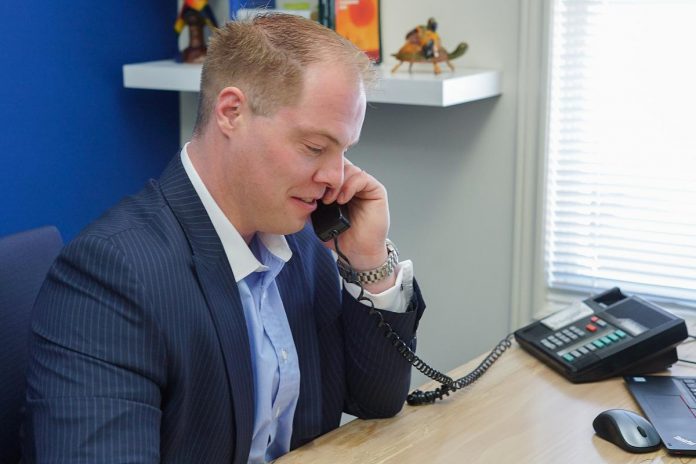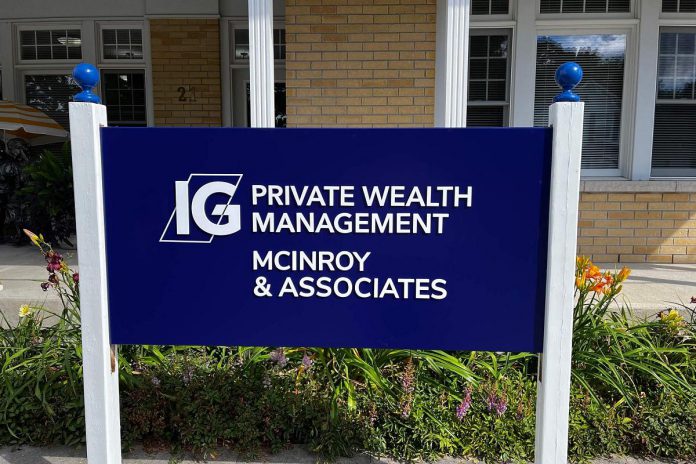
Dipping one’s toe into the retirement planning waters for the first time can be equal parts overwhelming, intimidating, and stressful.
As Executive Financial Consultant with Bobcaygeon-based McInroy & Associates Private Wealth Management, Adam McInroy CFP, CLU is very well aware of that.
Together with his team, he has made it his business to smooth the waters for clients, first by compiling an inventory of what retirement income options are available to them — the “puzzle pieces” as he calls them — and formulating investment, risk mitigation and, most importantly, tax planning strategies that will sustain and likely enhance that income for the years ahead.

“Our first step is to understand what pieces of that retirement income stream clients have in place or available to tap into, and there can be a lot of them — employer pension plans, deferred profit-sharing plans, government sources such as OAS, CPP, and GIS, and their own individual investments,” Adam explains.
“It’s not as streamlined as it once was. It used to be when you retired from a job, your employer replaced your paycheque with a pension. For many people these days, that isn’t what happens.”
“It’s not uncommon to see a lot of clients walk in who have a pension plan, but that company got sold. You kept working the same job for the new employer and, with that employer change, the retirement planning options also changed. It’s no longer a defined benefits plan — now it’s a defined contributions plan, a deferred profit sharing plan, or a number of alternatives. You still have that slice of guaranteed income, but now it’s up to us to manage this other slice to replace the paycheque you give up when you retire. Once you start trying to coordinate all that, it can become very confusing, time consuming, and overwhelming.”
In putting together a viable and sustainable retirement income plan for clients, Adam poses one crucial question as a starting point: What kind of lifestyle moving forward does the client desire and expect?
“More often than not, the strategy that we look at is more of a homogenized approach where we’re taking a little bit from this bucket and a little bit from that bucket,” he explains.

“Ideally we want to create a foundation of income that’s stable and maybe creates some tax liability, but never to the point where clients are paying more taxes than they have to,” Adam adds. “It’s a real fine art to manage income tax year after year because every year tax brackets change, tax credits change, tax planning strategies change, and your age changes.”
A major goal, Adam adds, is eliminating — or at least reducing — Old Age Security claw-back. He explains that’s done by “strategizing what bucket we’re pulling out of, how much we’re pulling out of that bucket, and when we’re doing it.”
Meanwhile, for those clients who aren’t where they need to be to realize their retirement goals, Adam says the biggest thing is to present them with “some simple steps they can implement in the next 90 days to start to put themselves on a better trajectory — to create a clear action plan so they’re not leaving the office thinking ‘I’m not where I need to be, but I’m not really sure what I need to do to get there.'”
He likens the process to that of a baseball batting coach who “watches your swing time and time and time again to finesse that stroke.”

“That’s our goal with clients. They’re going to step into the batter’s box and we’re going to see what they want to do, and then we’re going to start finessing and coaching them to where they need to be. Our team focuses on improving our clients’ financial outcomes. When it comes to retirement, we’ve been doing this for decades and have seen over that time what is required to not only successfully retire, but also enjoy retirement and pursue the lifestyle that the client has envisioned.”
Adam breaks retirement planning down into four steps that help clients get a firm grip on their retirement income and ensure they can live their retirement years on their terms:
- Understanding that Canada’s retirement income system consists of three tiers: government benefits, employer retirement plans and options, and personal investing through accounts, real estate holdings, and private corporations. These components are vital in understanding how to ensure a financially secure retirement.
- Understanding what your income needs really are, not just in year one of retirement but also what they are likely to be in year 15 of your retirement income plan.
- Optimizing taxable sources of income, while being mindful of tax credits and social benefits along with health and marital status.
- Making things simple. Consolidating invested assets and streamlining withdrawals make strategies such as tax planning, de-registration, and income splitting that much easier.
Adam says clients should always be asking questions of their financial advisor, including what his or her qualifications are — with the most important being the CERTIFIED FINANCIAL PLANNER (CFP) designation.
“The first big question should be ‘Are you a CFP?'” he notes. “A CFP professional doesn’t receive that designation from his or her investment dealer. It’s from a third party, FP Canada, and it holds us to is a standard of ethics and duty to do what’s in the best interests of our clients.”
Another important question is to ask how the financial advisor is compensated.
“It’s really important as a client or prospective client to understand how you’re paying the professionals you work with,” Adam explains. “Are they getting a flat salary, where maybe they’re not as engaged or involved in the day-to-day actions of your portfolio because they go home at the end of the day after collecting their paycheque? Or are they collecting an advisory fee that is based on their advice and guidance, which is directly aligned with the long-term value of your financial well-being?”
Adam notes a financial advisor should also be keeping their door open to clients, both for regularly scheduled meetings and impromptu check-ins.

“The planner should be checking in with you, but it’s also important to know that you can and should be reaching out to your CFP professional when something happens in your life. Life events don’t happen on a pre-set schedule. Things like divorce, birth of a child, purchasing a vacation property, an employer laying you off, or a critical illness, are a few times when you may not think it’s important to talk to your CFP professional but, in fact, it is critical to do so. Having them involved can result in a significant reduction in stress, as your financial plan could and should be adjusted to the new realities.”
Adam points out that communication is a two-way street, so it’s also important for clients to keep their advisor apprised of financial developments.
“It’s not about how much you make, it’s about how much you keep, how hard it works for you, and how many generations you keep it for,” he says.
McInroy & Associates Private Wealth Management is located at 21 King Street West in Bobcaygeon. You can email Adam at adam.mcinroy@igpwm.ca or call 705-738-2422. For more information about McInroy & Associates Private Wealth Management, visit www.mcinroypwm.com.
Investors Group Financial Services Inc.
This is a general source of information only. It is not intended to provide personalized tax, legal or investment advice, and is not intended as a solicitation to purchase securities. Adam McInroy is solely responsible for its content. For more information on this topic or any other financial matter, please contact McInroy & Associates Private Wealth Management.
This is one of a series of branded editorials created in partnership with McInroy & Associates Private Wealth Management. If your business or organization is interested in a branded editorial, contact us.


























